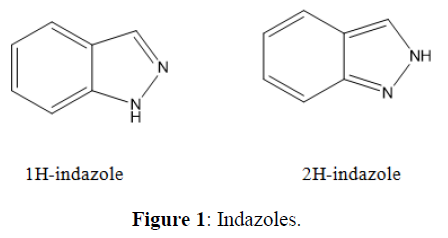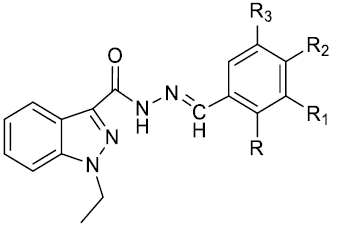Research Article - Der Pharma Chemica ( 2023) Volume 15, Issue 3
Synthesis, Characterization and Biological Evaluation of Schiffââ¬â¢s Bases Containing Indazole moiety.
Babasaheb S Zine1*, Sopan A Najan2, Shrikant P Dhonde1 and Mazahar Farooqui32Associate Professor, Department of Chemistry, Arts, Commerce and Science College, Sonai Tal. Newasa, Dist. Ahmednagar, Maharashtr, India
3Principal, Post Graduate and Research center, Maulana Azad College, Aurangabad, Maharashtra, India
Babasaheb S Zine, Associate Professor, Department of Chemistry, Bhagwan Mahavidyalaya ,Ashti. Dist. Beed, MS, India, Email: babasahebzine2011@gmail.com
Received: 27-Feb-2023, Manuscript No. dpc-23-92785; Editor assigned: 01-Mar-2023, Pre QC No. dpc-23-92785; Reviewed: 15-Mar-2023, QC No. dpc-23-92785; Revised: 17-Mar-2023, Manuscript No. dpc-23-92785; Published: 24-Mar-2023, DOI: 10.4172/0975-413X.15.3.34-37
Abstract
Indazole containing derivatives represent one of the most important heterocycles in pharmaceuticals. Substituted indazole derivatives bear a variety of functional groups and display versatile biological activities. A series of new Indazolyl derivatives have been prepared from commercially available N-substituted-3-indazole carboxylic acid and methanol with sulphuric acid. Synthesis of these compounds proceeds through the formation of 1-ethyl-1H-indazole -3-carboxylate, by acidic esterification, then conveted in to 1-ethyl-1H-indazole -3-hydrazide using hyrdazine hydrate in ethanol at reflux temperature. Then 1-ethyl-1H-indazole-3-hydrazide was condensed with different substituted benazadehydes using catalytic amount of conc. sulphuric acid in ethanol. Some of the synthesized derivatives were then evaluated for antibacterial activity against different bacterial strains which shows good Antibacterial activities.Keywords
Indazole derivative, anti-bacterial, Esterification, Hydrazine
INTRODUCTION
The nitrogen-containing heterocycles are important building blocks for many bioactive natural products and commercially available drugs. As pharmacologically important derivatives, they have attracted considerable attention from chemists [1]. Indazoles are one of the most important classes of nitrogen-containing heterocyclic compounds bearing a bicyclic ring structure made up of a pyrazole ring and a benzene ring. Indazole usually contains two tautomeric forms, 1H-indazole and 2H-indazole (Figure 1).
Since 1H-indazole is more thermodynamically stable than 2H-indazole, it is the predominant tautomer [2].
Indazole derivatives scracely occur in nature, but this particular nucleus in a variety of synthetic compounds possesses a wide range of pharmacological activities, such as anti-inflammatory, antiarrhythmic, antitumor, antifungal, antibacterial, and anti-HIV activities [3-8].
Diversely substituted indazole-containing compounds furnished with different functional groups represent significant pharmacological activities and serve as structural moiety in drug molecules. For example, niraparib has been widely used as an anticancer drug for the treatment of recurrent epithelial ovarian, fallopian tube or primary peritoneal, breast and prostate cancer [9]. Pazopanib is a tyrosine kinase inhibitor, which has been approved by the FDA for renal cell carcinoma [10]. Bendazac and Benzydamine are two commercially available anti-inflammatory drugs, which contain the 1H-indazole scaffold [11]. In light of indazole scaffolds exhibiting a broad spectrum of pharmacological activities, numerous methods have been developed to construct of these heterocycles with better biological activities. There are some excellent reviews, which have been published on the biological properties of this class of compounds [12-14].
The presence of medicinal properties in substituted Indazole derivatives and Indazole 3 corboxylic acid represents a pivotal intermediate [15] for preparation of biologically active Indazole analogs. Indazole 3 corboxylic acid also the precursor of drugs like Granicetron which is available in the market [16-20].
MATERIALS AND METHODS
Melting points were taken on a precision melting point apparatus (DBK) instrument and are uncorrected. IR spectra were obtained in potassium bromide (KBr) disks on a Bruker IR- spectrometer, and 1H NMR spectra were obtained on deuterated chloroform (CDCl3 ) or DMSO-d6 solution on a Varian 400 MHz spectrometer. Mass spectra were recorded on a Micro Mass Spectrometer by waters. All the raw materials, reagents and solvents used were of commercial grade only. All reactions were routinely followed by TLC (Scheme 1).
EXPERIMENTAL AND SPECTRAL DATA
Synthesis of 1-ethyl-1H-indazole -3-carboxylate (2)
To the stirred suspension of N- Ethyl indazolic acid (10 gm, 0.056 mole) in 100 ml ethanol added 10 ml sulphuric acid dropwise. The reaction mixture heated to reflux for 4 hrs. After completion of reaction, reaction mass concentrated and neutralized with saturated sodium bicarbonate solution and extracted with 100 ml ethyl acetate, ethyl acetate layer wash with 50 ml water, dried over anhydrous sodium sulphate and concentrate on rotavepour solid obtained was filtered, washed with chilled ethyl acetate (10 ml), Yield. 82 %
Synthesis of 1-ethyl-1H-indazole -3-hydrazide (3)
To the suspension of 1-ethyl-1H-indazole -3-carboxylate (10 gm, 0.52 mole) in ethanol 20 ml. Were added hydrazine hydrate (5.2 gm, 0.10 mole) and 1 ml of glycial acetic acid. The reaction mass was heated at reflux temp for 4-6 h. After completion of reaction, reaction mixture was cooled to room temperature separated solid was filtered and washed with chilled 5 ml ethanol and dried at 50-60ºC. Yield. 78 %
Synthesis of 1-ethyl N-(4-(trifluoromethyl) benzylidene) 1H -indazole-3-carbohydrazide (4)
To the stirred solution of 1-ethyl-1H-indazole-3-carbohydrazide (2.0 gm, 0.010mole) in 20 ml of absolute ethanol added 4-(trifluoro methyl) benzaldehyde (1.8 gm, 0.010 mole) and 1 ml of conc. sulphuric acid. The reaction mixture was heated to reflux for 6 hrs. After the completion of the reaction, 60 ml of water was added to the reaction mixture and stirred for 1 hr. The solid obtained was filtered and washed with water, dried at 45-50ºC.
Similarly the other derivatives of this series were prepared. Their structures have been confirmed by IR, 1HNMR and Mass spectra.
Physical data and Spectroscopic data for the respective compounds are presented in the following tables.
N-(4-benzylidene-1-ethyl-1H-indazole-3-carbo hydrazide (4a)
Yield: 71%, M.P.190-1920C, IR (KBr) cm-1: 3213 (-NH), 2944 and 2816 (Ar-CH stretching and bending), 1656 (CONH). 1H NMR CDCl3: δ 1.94
(t, 3H, -CH3 protons), δ 3.14 (q, 2H, -CH2-CH3 protons), δ 7.21-8.41 (9H, Ar-H), δ 8.46 (s, 1H, N=CH imine proton), δ 10.15 (s, 1H, CONH proton, exchangable with D2O). MS (m/z): 293 [M+1].
1-ethyl-N-(4-(trifluoromethyl)benzylidene)-1H-indazole-3-carbo hydrazide (4b)
Yield: 80%, M.P.197-1990C, IR (KBr) cm-1: 3203(-N,H), 2940 and 2806 (Ar-CH stretching and bending), 1652(CONH), 1H NMR CDCl3: δ 1.45 (t, 3H, -CH3 protons), δ 3.02 (q, 2H, -CH2-CH3 protons), δ 7.25-8.46 (8H, Ar-H), δ 8.42 (s, 1H, N=CH imine proton), δ10.21(s, 1H, CONH proton, exchangable with D2O). Mass (m/z): 361(M+1).
N-(3-fluorobenzylidene)-1-ethyl-1H-indazole-3-carbohydrazide (4c)
Yield: 71%, M.P.200-2020C, IR (KBr) cm-1: 3222 (-NH), 2945 and 2816 (Ar-CH stretching and bending), 1659(CONH), 1H NMR CDCl3: δ 1.95 (t, 3H, -CH3 protons), δ 3.32 (q, 2H, -CH2-CH3 protons), δ 7.11-8.32 (8H,Ar-H), δ 8.46 (s, 1H, N=CH imine proton), δ 9.98 (s, 1H, CONH proton, exchangable with D2O). Mass (m/z): 311(M+1).
N-(2-bromobenzylidene)-1-ethyl-1H-indazole-3-carbohydrazide (4d)
Yield: 82%, M.P.230-2320C, IR (KBr) cm-1: 3200(-NH), 2934 and 2800 (Ar-CH stretching and bending),1645(CONH)., 1H NMR CDCl3: δ 2.94 (t, 3H, -CH3 protons), δ 3.43 (q, 2H, CH2-CH3 protons), δ 7.15-8.37 (8H,Ar-H), δ 8.32 (s, 1H,N=CH imine proton), δ 9.90 (s,1H,CONH proton, exchangable with D2O),Mass (m/z): 371(M+1).
1-ethyl-N-(2-nitrobenzylidene)-1H-indazole-3-carbohydrazide (4e)
Yield: 72%, M.P.237-2390C, IR (KBr) cm-1: 3200(-NH), 2934 and 2800 (Ar-CH stretching and bending), 1645(CONH)., 1H NMR CDCl3: δ 2.15 (t, 3H, -CH3 protons), δ 3.22 (q, 2H, CH2-CH3 protons), δ 7.05-8.11 ( 8H, Ar-H), δ 8.26 (s, 1H,N=CH imine proton), δ 9.84 (s,1H,CONH proton, exchangable with D2O), Mass (m/z): 338(M+1) (Table 1).
|
Antibacterial activity in terms of Zone of Inhibition (mm) when tested at 40 mcg/disc) | |||||||||
| Entry | R | R1 | R2 | R3 | K.pneumonia | S.typhy | P.auroginosa | B. Subtilis | E. coli | S. auerues |
| 4a | H | H | H | H | 3 | 2 | 1 | 5 | 0 | 2 |
| 4b | H | H | CF3 | H | 7 | 5 | 6 | 4 | 3 | 5 |
| 4c | H | F | H | H | 8 | 4 | 7 | 4 | 5 | 3 |
| 4d | Br | H | H | H | 2 | 3 | 4 | 7 | 1 | 1 |
| 4e | H | NO2 | H | H | 3 | 1 | 3 | 2 | 1 | 2 |
| Gentamicin(40 mcg/disc) | 13 | 11 | 17 | 15 | 11 | 7 | ||||
| Kanamycin(40 mcg/disc) | 18 | 14 | 21 | 15 | 13 | 9 | ||||
CONCLUSION
The above series tested for their antibacterial activity with respect to agar disc method. The fluoro groups 4b and 4c has improved the antibacterial property as compared with the other derivatives. The derivatives 4b and 4c has good killing properties for K. pneumoniae in the group. The bactericidal properties of 4b and 4c against the species of P. aeroginosa have improved over other derivatives of the same group. But the overall killing or inhibiting the growth of bacteria is inferior as compared with the standard Gentamicin and Kanamycin drugs.
ACKNOWLEDGMENT
Author is greatly thankful to the Management of Maulana Azad College, Aurangabad and Principal, Bhagwan Mahavidyalaya, Ashti. Dist - Beed for the supports in the technical front.
REFERENCES
- Gao MC, Xu B. Chem Res. 2016, 16: p. 1701-1714.
- Teixeira FC, Ramos H, Antunes IF, et al., Molecules. 2006, 11: p. 867-889.
- Vidyacharan S, Murugan A, Sharada DS. J Org Chem. 2016, 81: p. 2837-2848.
- Shinde AH, Vidyacharan S, Sharada DS. Org Biomol Chem. 2016, 14: p. 3207–3211.
- Behrouz S. J Heterocyclic Chem. 2017, 54: p. 1863-1871.
- Jayanthi M, Rajakumar P. J Heterocyclic Chem. 2017, 54: p. 3042–3050.
- Lavrard H, Popowycz F. Synthesis. 2018, 50: p. 998-1006.
- Bogonda G, Kim HY, Oh K. Org Lett. 2018, 20: p. 2711-2715.
- Scott LJ. Drugs. 2017, 77: p. 1029-1034.
- Baddam SR, Kumar NU, Reddy AP. et al., Tetrahedron Lett. 2013, 54: p. 1661-1663.
- AI-Bogami AS. Res Chem Intermed. 2016, 42: p. 5457-5477.
- Gaikwad DD, Chapolikar AD, Devkate CG, et al., Eur J Med Chem. 2015, 90: p. 707-731.
- Dong JY, Zhang QJ, Wang ZT, et al., Chem Med Chem. 2018, 13: p. 1490-1507.
- Wan YC, He SZ, Li W, et al., Med Chem. 2018, 18: p. 1228-1234
- Fludzinski P, Evrad DA, Bloomquist WE, et al., J Med Chem. 1987, 30: p. 1535.
- Cyr P, Regnier S, Bechara WS, et al., Org Lett. 2015, 17: p. 3386-3389.
- Wei W, Wang Z, Yang XK, et al., Adv Synth Catal. 2017, 359: p. 3378-3387.
- Zhang ZG, Huang YY, Huang GQ, et al., J Heterocyclic Chem. 2017, 54: p. 2426-2433.
- Tang M, Kong YF, Chu BJ, et al., Adv Synth Catal. 2016, 358: p. 926-939.
- Zhu XQ, Mao S, Guo DD, et al., Chem Cat Chem. 2017, 9: p. 1084-1091.
Indexed at, Google Scholar, Crossref
Indexed at, Google Scholar, Crossref
Indexed at, Google Scholar, Crossref






